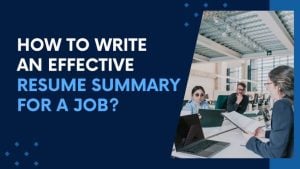Doer vs. Achiever Resume: A Guide to Designing an Impressive Resume
 Publié le 19 September 2024
Publié le 19 September 2024
By understanding the difference between a doer vs. achiever resume, you can showcase your abilities and impress hiring managers.
Building a resume that highlights your best attributes means understanding whether you are a doer or an achiever. It’s also about how to adapt and format your resume to highlight each approach’s strengths – and compensate for its weaknesses.
If you’re not sure where to start when building your doer vs. achiever resume, then look no further than this expert guide. Here, we’ll give you the lowdown on what being a doer and an achiever means and how you can tailor your resume accordingly to land your dream job. Let’s get into it.
State of the Job Market in 2024
In an ideal world, everyone will work for a company that cares for them. One that provides them with everything from bonuses and benefits to a regular employee review so they can thrive in their role. Finding an employer that is invested in your future and wants your loyalty is rare, but not impossible.
Until then, you need to job hunt.
Unfortunately, in 2024, this is harder than it has been in the immediate past. We aren’t at post-2008 desperation levels yet, but hiring is slowing down. For example, as of June 2024 in the USA, hiring was below the 2010 to 2019 average.
Image sourced from Reuters
These numbers don’t mean you cannot get hired. They just mean you need to do more to get your resume to stand out and secure your next big job.
How Employers Sort Through Potential Candidates
Before we get into how you can stand out in the job market today with an eye-catching resume, it’s crucial to understand how employers and recruiters find people.
Here are a few ways that the hiring process has changed – and continues to change – in 2024 and beyond:
- Greater emphasis on AI and ML screening tools, including the use of AI resume builders to enhance candidate profiles
- More businesses are becoming proactive with their hiring rather than reactive
- More businesses are looking for those who can steer them into the future
- The recruitment process has lengthened
- Utilization of an online quiz builder to assess candidate skills and compatibility with company culture
As a job seeker, this means that you need to:
- Properly format your resume so AI applicant tracking systems can easily read and understand it
- Establish yourself as a solutions-led leader in your field
- Stay sharp by expanding your skillset to include cutting-edge topics like AI
- Expand your AI proficiency and employ a desktop time tracker to efficiently orchestrate your job search activities, ensuring timely application submissions and follow-ups.
- Be prepared to play the long game
The first step, of course, is to brush up your resume. But before you jump into this endeavor, it’s essential to understand if you are a doer or an achiever. This will enable you to fully understand the value you’d bring to any role, and what you should highlight in your resume.
Free to use image sourced from Unsplash
What Does It Mean to Be a Doer?
Doers are task-focused. They take on and accomplish the responsibilities assigned to them, which makes them very action-oriented and reliable. Some may see doers as those who simply get the job done, as opposed to leaders who guide others and lead by example. This, though, is not always the case.
What Does it Mean to Be an Achiever?
An achiever emphasizes their accomplishments. For example, let’s imagine that, in your previous role, you noticed a disconnect between your department’s messaging methods. You petitioned your manager (or even business owner) and led the adoption of a unified messaging platform in order for the company to achieve greater communication and efficiency.
Doer vs. Achiever: Which Is Better?
All businesses need both doers and achievers. The reality is that every doer can also be an achiever, and every achiever has to be a doer to a certain extent.
Where does that leave you? In most cases, it’s all about how you view the work that you’ve done. Doers are focused on the steps that need to be done and then complete them. Achievers think more about the outcomes, whether they be short or long-term.
How to Figure Out If You’re a Doer or an Achiever
While you will always be both a doer and an achiever, most will lean one way or another. Ultimately, doers will:
- Focus more on the tasks they complete
- Think about their accomplishments based on the work they complete
- Put more emphasis on the steps needed to complete a project
As such, doers tend to be more practical and analytical. Their focus is on the steps, which means they’re better suited to replicate their work but aren’t as excellent at explaining the benefits of their work.
Achievers, on the other hand, tend to:
- Focus more on the results of their work
- Think about their accomplishments based on their impact
- Put more emphasis on the outcome of completed projects
As you can see, achievers tend to be more future-thinking. This makes them well-suited to leadership positions, but since there’s less focus on the practical steps to get there, they may falter in explaining how they got the results they did.
Free to use image sourced from Pixabay
How to Write a Doer Resume
If you are more of a doer, then it’s important to shuffle your resume around to include more information about your achievements and the skills needed to get there. This shifts the emphasis away from what you’ve done to the value of your skills and how they fit into a new employer’s workforce. Here’s how.
- Outline Your Achievements
Go through your day-to-day responsibilities and focus on each of the steps you need to take to complete a task or project. For example, if you are a customer service representative, don’t just say, “Managed a team of five”. Say something like, “Managed a team of five while simultaneously handling large volumes of customer queries and maintaining the company’s CRM up-to-date.”
- Use Powerful Action Verbs
An easy way to improve your resume is to use powerful action verbs. This is particularly useful when you want to showcase soft skills.
If you are a buyer, for example, and use negotiation, communication, and interpersonal skills to acquire new contracts with suppliers, you could say: “Cultivated strong relationships with suppliers with enhanced communication and interpersonal skills to negotiate mutually beneficial contract terms.”
- Emphasize Skillsets, Licenses, and Certificates
If you have unique skills, are licensed in specific tasks, or hold certificates, emphasize these. Put any third-party licenses and certificates at the top of your resume. Link those skills in your resume, showcasing how you use your unique skills to achieve outcomes and results.
Free to use image sourced from Unsplash
How to Write an Achiever Resume
To help you optimize your resume as an achiever, you’ll want to use the tips below.
- Use the CAR Method (Challenge-action-result)
You want the achievements you use to be concrete. An excellent way to do this is to use the Challenge, Action, Result method. For example, say you increased research workflows by relying on a data vendor to reduce time to print for your marketing campaigns. Outline the entire process rather than just focus on the outcome (decreased time to print by 28%).
- The Challenge: Slow research and analytics
- The Action: Leveraged a data vendor to secure high-quality information
- The Result: Improved marketing campaign development, decreasing time from concept to publication.
In your resume, this may sound like: “Accelerated marketing campaign development by leveraging a data vendor to access high-quality information, resulting in a 28% reduction in time-to-publication.”
- Be Concise
It can feel like you need to go on and on to explain your achievements and how you got there, but you don’t. Try to put each CAR achievement into one single sentence. It is doable. The secret is to view your resume as an overview. The cover letter and interview are there so you can fully explain your achievements.
- Highlight Specific Skills
One tip you can take from your doer counterparts is to put your skills front and center. Adding the skills you have throughout your resume helps you highlight your universal talents. If you have specific qualifications or have achieved important goals and milestones, include this in your short bio at the top.
Free to use image sourced from Pixabay
Top Resume Tip Advice for All Job Hunters
Doers and achievers both need to know about all the CV mistakes to avoid. This applies to those looking to get their first entry-level job and highly talented senior specialists and managers, whether they are doers or achievers. To avoid making those mistakes, simply follow these tips.
Match Language With the Job Description
CV parsing is standard today. This means a kick-ass resume can be passed over just because it doesn’t use the keywords that hiring managers seek. The majority of resumes fall into this trap.
The good news is that it’s very easy to avoid these issues as both a doer and an achiever. The secret is to review the job experience description, pick out the keywords, and ensure your resume includes them.
Simplify Your Resume Design
A bad resume is sometimes just one that’s not formatted properly. The resume itself can look incredible – for humans. However, automated systems may pass it over if it’s not formatted in a standard way. Simplify the design, make it easier for robots to understand, and then let the language wow the humans that eventually get to it.
Optional: Put Together a More Creative Portfolio
In some fields, like design, a resume and cover letter alone might not cut it if you want to showcase your wider professional online presence. A good idea is to create a website or standalone landing page that acts as your visual, interactive portfolio.
Always Add a Cover Letter
As we mentioned, the ideal candidate always tailors their application to each job description. The biggest way you will want to do this is with your cover letter. A powerful, compelling cover letter can help you stand out by letting you highlight to employers how your experience matches all of the needs outlined in the job description.
Make Sure You Submit Your Resume in the Right Place
Never use the “Easy Apply” button without going through the whole job vacancy details first. Instead, you’ll want to read through the entire job description to see if there’s an email you will need to apply to. Hiring managers use this method to avoid job spammers since they rarely read through the entire application or tailor it.
Another easy way to stand out is to visit the company’s main website and see if it has a careers section. If it does, apply directly through their website. Otherwise, see if you can find the hiring manager on LinkedIn and contact them directly.
Leverage Your Network
Image sourced from Zippia
One of the best ways to secure a job interview is to use your professional network. A staggering 40% of all new hires get their position because they were referred by an employee. This is very high, considering only 7% of candidates are referrals in the first place.
In short, if you want to make your application stand out, you need a referral. Use your network to see what positions are out there, and take advantage of those relationships you’ve acquired along the way.
Doer vs. Achiever Resume: Understand the Differences, Land Your Dream Job
Research from hiring experts such as Indeed is showing that the job postings index is down, with fewer employers seeking to fill positions at the moment. The bottom line? To land your dream job, you need to really stand out. One way to do this is to understand a doer vs. achiever resume, establish which one best suits you, and tailor your resume accordingly.
By adjusting your language and focus and using the top resume-writing tips in our guide, you can supercharge your resume and wow employers. What are you waiting for? Start creating an optimized resume today!







